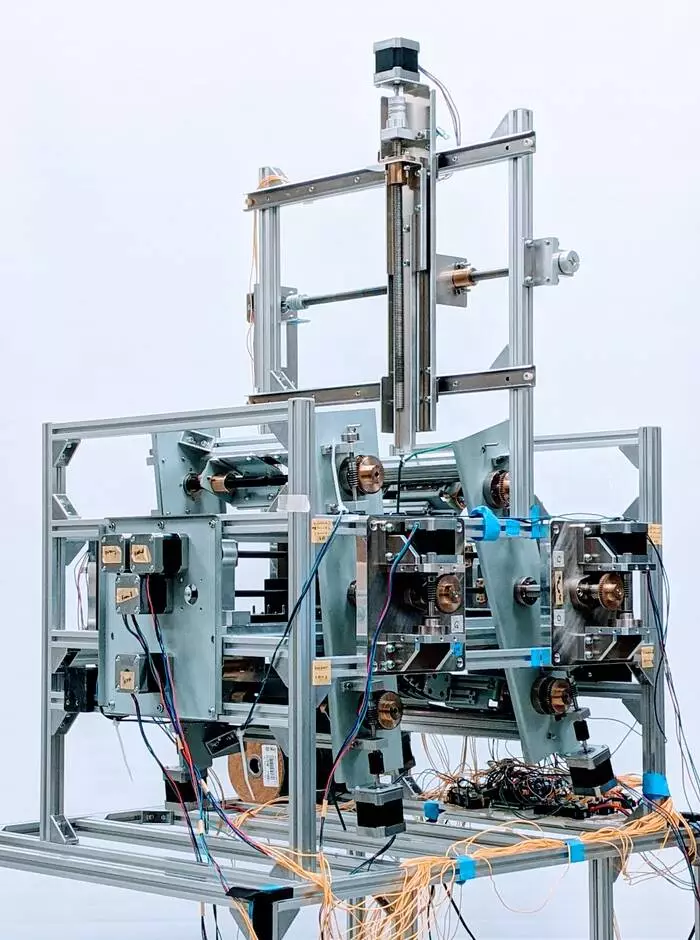A new materials technique has taken cues from Grandma's yarn bag and cutting-edge technology, and it could see us 'solid knitting' whole furniture sets, as well as the fabrics that cover them. What's more, it can be unraveled to use again in a completely different form, making it sustainable, versatile and a whole lot of reconfigurable fun.
This is the decade-long work of Yuichi Hirose, who first dreamed up this one-of-a-kind technique when he was a student at Keio University in Tokyo. There, working on digital fabrication methods in the Hiroya Tanaka Laboratory, he had the idea to incorporate knitting – yes, the needles and yarn type – into a new kind of manufacturing.
“My dream is to have these solid knitting machines everywhere in the world,” Hirose said, who is now working on making it a reality with his research team led by James McCannnow at Carnegie Mellon University.

The prototype of their solid knitting machine made its debut this week the annual SIGGRAPH conference showcasing computer graphics and interactive techniques, where it won an honorable mention in the Best Paper category.
So what is it exactly? As that video explains, solid knitting isn't a world away from 3D printing, as objects are built by layers with material fed through an automated, programmed machine. The machine has a series of hooked needles with latches that can be instructed to engage with manipulating the yarn, as the rows of knitting build both horizontally and vertically.
"Solid Knitting is a new technique to fabricate dense, firm objects via knitting," Hirose wrote in a blog post for SIGGRAPH. "It builds objects up layer by layer similar to 3D printing, but these layers are connected to each other by the topologically intertwined stitch structure of knitting. So, it can easily be unraveled and re-knit, unlike other 3D printing methods which require finished objects to be laboriously melted down and re-extruded into filament in order to be recycled."
"To automate solid knitting, we built a working prototype, solid knitting machine, and a design tool to help program the machine," he continued. "In the tool, users design objects by connecting different types of blocks, what we call 'augmented stitch volumes.' They are associated with code fragments that represent machine operations, described in a language we also developed, 'solid knitout.' The tool combines the code fragments from each block into a program to run the machine."
Hirose believes there's a future in the technique for solid-knitting tables, chairs and more, and because the designs can essentially be unpicked and reprocessed by the machine into something totally different, there's great scope for creativity and adaptability.
“It can be hard to wrap your head around the concept,” said McCann, leader of the Carnegie Mellon Textiles Lab. “But it’s a very cool idea, and one that has a lot of promise.”
The current prototype, the culmination of several years' work, demonstrates its abilities with thick elastic cord, and even though it's "surprisingly firm," according to McCann, it admittedly doesn't look like it would make a particularly comfortable ottoman, for example.

Hirose's goal is to be solid knitting thin thread and fibers, which would be woven so closely together they'd appear more like hard materials.
"By making the thread thinner, when the resolution increases, it should be possible to use it for parts and components," he told Japanese site InnoUvators. "For example, most T-shirts across the world are knitted with fine thread without feeling like it is knitted. In the same way, I wanted to create a knitted item that looked solid, like plastic, but could be unraveled, updated and changed into a different form in the future."
As of now, the prototype can only knit triangular or rectangular solid shapes, but the goal is to create a machine that can be programmed to knit complex, complete objects such as a chair.
“We hope that other people out there are going to build their own solid knitting machines and come up with ideas we haven’t yet explored,” McCann added.
The research was published in the journal ACM Transactions on Graphics.
Source: Carnegie Mellon University






